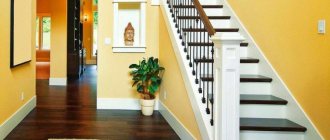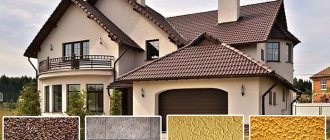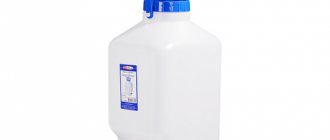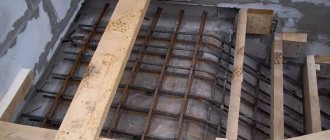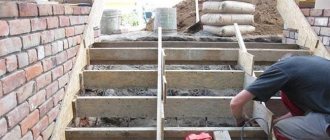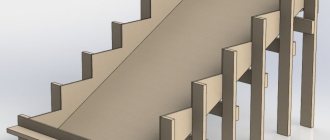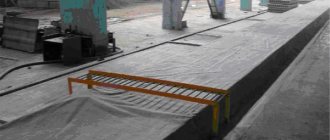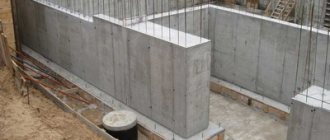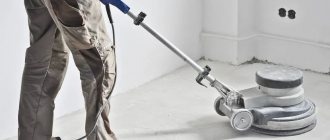Beton-House.com
Website about concrete: construction, characteristics, design. We combine the experience of professionals and private craftsmen in one place
Thanks to the right finishing material, a concrete staircase can become a central element in the house
One of the most common solutions for arranging interfloor passages is a staircase. Such structures are distinguished by high strength, long service life and significant wear resistance.
But the appearance of the cement mortar leaves much to be desired, which is why in most cases the stairs are finished with concrete. Various materials can be used for cladding steps. In this article we will look at how such a structure can be finished and evaluate the main qualities of facing materials.
- Possibilities for finishing internal steps
Concrete steps
Any staircase performs very specific practical functions: the design serves to organize free entry into the building or movement between floors. Such objects are areas with increased load. For this reason, the material for their construction is selected to be as durable and wear-resistant as possible.
Monolithic stairs are the most preferred option for constructing transitions in any type of building.
The design can be arranged in 2 ways:
- pouring into formwork at the construction site;
- installation of a finished factory span structure.
Advantages of concrete stairs
The main advantage of such a staircase is that when installed during the construction process, it significantly strengthens the main structure of the house.
In addition, regardless of the production method, concrete spans have certain advantages over other materials:
- the properties of the concrete solution guarantee a long period of operation;
- Cement-based structures are absolutely fireproof;
- using the necessary additives, concrete blocks become moisture resistant;
- reinforced structure can withstand significant physical loads;
- the plasticity of the solution makes it possible to create spans of almost any shape;
- monolithic casting technology ensures that the steps will not become loose or begin to creak over time;
- The material is compatible with absolutely any type of finishing material.
It is the latter quality, despite its absolute advantages, that very often forces one to choose concrete. Often, at the construction stage, owners are not yet sure of the materials and methods of interior decoration. By arranging a monolithic structure, you can be sure that further finishing of such concrete structures will not create any difficulties in terms of implementing design ideas.
Thanks to steel reinforcement and the monolithic process, stairs are the most durable of all types of interfloor structures
Necessity of finishing
Unprotected concrete will lose its strength characteristics over time. This material, although very durable, can nevertheless quickly become brittle without proper processing. Moreover, the destruction will occur unnoticed, and this effect will be visible at a fairly late stage.
You can avoid negative impacts by arranging a layer of decorative material.
This decoration of stairs will perform several functions at once and solve a number of problems:
- will increase the service life of the structure;
- will reduce the cost of carrying out current repairs;
- will prevent premature destruction and aging of concrete;
- will improve the appearance of the staircase and fit it into the interior of the house.
Without finishing, concrete will begin to deteriorate over time.
Coloring
Long gone are the days when painting concrete stairs was a temporary solution. Modern paints based on various resins make it possible to paint concrete with high quality, and the coating is durable and inert to the chemical effects of aggressive agents.
At the same time, compared to other finishing options, the price of paints compares favorably. Of course, it’s hardly worth painting the main staircase, but monolithic stairs to basements or attics can easily be decorated with epoxy or acrylic paint.
The paint is also remarkable because, in addition to the protective layer, it improves some properties of the monolith:
- enhances the strength of the concrete surface and, as a result, extends the life of the structure as a whole;
- significantly reduces the risk of delamination and cracks;
- increases the resistance of steps to abrasion;
- improves the antistatic properties of the monolith.
Adding construction quartz sand to the paint will make the steps less slippery
Using various additives, several practical operational problems can be solved along the way:
- make the surface of the steps non-slip, reducing the risk of injury;
- the painted surface is quite easy to clean;
- A wide selection of coloring pigments will allow you not only to paint the staircase, but to turn it into an interesting element of the interior.
Important! Different types of paints require different conditions during application. Before painting the steps, be sure to prime the concrete. The type of primer and method of application are specified by the manufacturer on the label.
Material selection
When deciding how to finish a staircase, several factors should be taken into account.
Important criteria in choosing a finish are:
- location of the stairs in the space of the house;
- size and shape of steps;
- planned interior design;
- wishes and physical capabilities of the residents of the house.
Decorating a staircase in a house with rectangular steps does not impose any restrictions on the choice of material. It’s a different matter when it is planned to cover it with a patterned tread or in the situation of installing winder steps.
In such cases, it is better to select a cladding that can be easily cut or leveled. Among other things, some finishing materials are more effective than others in reducing the level of injuries on stairs by absorbing falls.
An important point is noise absorption. Therefore, when deciding what to clad the stairs in your house with, take into account the soundproofing properties of the material.
Of course, finishing the stairs with carpet, laminate or natural wood will significantly reduce the sound level. And when tiling the steps with tiles, stone or porcelain stoneware, the opposite effect will occur: the sound from the steps will increase.
The choice of material is also influenced by the experience of the persons carrying out the covering. Finishing concrete stairs with your own hands will limit your options if you are not a professional builder. Some materials require special tools and very specific skills.
On a note! All of the above applies to indoor stairs. When choosing what to decorate stair steps on the street, these requirements will be supplemented by the factors of frost resistance, moisture absorption and resistance to active chemicals.
The concrete structure itself has a rather boring appearance.
Possibilities for finishing internal steps
So, if the staircase is concrete, how can it be finished and what materials are suitable for this type of work? In practice, there are several such materials. They all have their advantages and disadvantages, and the choice should be made based on the specific situation.
More often than others, the following are used for cladding interior staircases:
- ceramic tiles, including porcelain tiles;
- stone: marble or granite;
- wood of various species, most often used: oak, beech, ash, larch;
- laminate with increased abrasion resistance;
- rolled materials: carpet and linoleum;
- different types of paint.
It should be noted that cladding is often done in combination using two or more materials. Let's take a closer look at the advantages and disadvantages of each finishing method.
Staircase finishing options
The modern market offers a variety of staircase finishing options, among which it is not difficult to choose exactly what you need. The main thing is to first determine the basic requirements and carefully study all the properties of different types of coating.
Painting concrete stairs
Painting the stairs is the simplest and most cost-effective finishing option. Modern paint and varnish coatings offer a number of advantages: several thin layers create a durable and monolithic coating, the ability to extend the life of concrete, high paint adhesion and a long period of maintaining the original appearance, elasticity and wear resistance, the ability to create a coating with an anti-slip effect.
Paints are available in a wide range of colors and shades; some compositions have the ability to eliminate minor unevenness in concrete. It is also important that cleaning and washing stairs painted with a good composition is quick and easy.
Among the disadvantages of painting, it is worth noting only such as a certain simplicity in the appearance of the stairs (which, nevertheless, is very important in modern interiors in the style of minimalism and high-tech), the need to perfectly level the surface of the concrete before starting work.
When choosing compositions, you should pay attention to those that are intended specifically for concrete. The process itself is very simple - before painting, you need to carefully level, clean the concrete, coat it with a primer (if necessary), then apply 1-2 layers of paint with a roller or brush (everything is usually indicated in the instructions on the packaging of the composition).
Choosing carpet or linoleum
Another affordable option for finishing a concrete staircase in a house that is already considered traditional. Despite the fact that over the past years carpets have gradually gone out of fashion, this option for stairs is of good quality. Typically, a special rubber-based carpet is chosen for finishing the structure.
Laying and fixing the carpet is carried out using two methods: using a special adhesive or using decorative corners, which are mounted at the base of the steps with self-tapping screws, guaranteeing a clear repetition of the contours and a tight fit.
The main advantages of carpet:
- Comfortable for movement and pleasant to the touch, which is especially important in winter.
- Large selection of materials with different thicknesses and pile heights. But more often they choose lint-free carpets - loop fabrics, which are easier to clean.
- Relatively low cost of coverage.
- A wide selection of colors, original prints, the ability to combine carpet with different types of decorative overlays (corners, for example).
- Safety and environmental friendliness - modern types of carpet do not have harmful inclusions, do not emit toxins into the atmosphere, and are not attractive to microorganisms.
- Installation of carpet can be done with your own hands - you just need to purchase the covering according to area calculations, then unfold it and allow it to unfold under its own weight in the room for at least a day, then attach it with special glue or strips with self-tapping screws.
Among the disadvantages of carpeting, it is worth mentioning the following: the synthetic top layer of material is hard and can cause the skin to “punch” when falling, some coatings have a low level of wear resistance (this disadvantage can be leveled out by choosing material of class 23 for high-traffic areas or class 33 for rooms with a continuous flow of people).
Linoleum has also proven itself quite well - it is usually fixed with a special glue with additional fasteners and decorative corners.
For stairs, you usually do not choose very dense linoleum, which will be difficult to bend to the shape of the steps. Otherwise, the material is in no way inferior to carpet, but usually lasts longer.
Facing with laminate or parquet boards
Parquet and laminate are also well suited for finishing concrete steps. The materials have excellent sound/heat insulation properties; the planks can be 6-12 millimeters thick (and the thicker the better). Thick lamellas are easier to install, stronger and more durable. The wear resistance of the coatings is high due to the top protective layer.
The simplest installation option is obtained when the width of the lamellas is equal to the width of the steps - in this case, you can do the cladding yourself. When the plank is a little wider, it will have to be trimmed, but narrower boards are not suitable for finishing.
Laminate and parquet can be attached to a concrete staircase using several methods, but the fastest and easiest is installation directly on the concrete using glue. What you will need for the job: the finishing material itself, the edge profile in the required volume (calculated by the total length of the steps), screws and dowels, decorative overlays for the profile, special glue, screwdriver. Before starting work, the lamellas are unpacked and allowed to stand in the room for at least a day.
The process of installing parquet and laminate flooring on a concrete staircase:
- Carefully leveling the concrete surface, removing debris and dust, covering with primer.
- Gluing the aluminum edge profile - the part with the holes for the screws should fit into the bottom step. Apply glue only to the edge of the upper step, then drill holes in the appropriate places, insert a dowel, screw in a self-tapping screw, the head of which should not protrude above the profile.
- Applying glue to the lamella, gluing it to the top plane of the step, then to the end plane. The profiles have protrusions that repeat the shape of the laminate lock - locks on the planks are placed in the same way. After gluing, they are snapped into place.
- Excess glue should not protrude; it should be removed with a damp cloth. Once finished, glue is applied to the overlay that covers the profile.
The main advantages of finishing concrete stairs with laminate and parquet: naturalness of the material, the ability to install the coating yourself, maintainability, a large selection of textures and shades, easy maintenance, good level of heat/sound insulation, low weight, combination with different interiors.
Finishing with ceramic tiles or porcelain stoneware
This material is used for finishing stairs inside and outside buildings. Many manufacturers offer ready-made collections of tiles designed for finishing steps. They are distinguished by the presence of shaped parts - edges, steps, risers, baseboards, railings. And all of them are suitable for standard configuration designs.
If tiles are selected for outdoor use, the packaging should be marked with a snowflake. But porcelain stoneware demonstrates the best frost resistance indicators. Laying tiles indoors and outdoors is carried out according to the same principle as tiling a regular flat floor.
The main advantages of finishing concrete stairs with ceramic tiles:
- Wear resistance and durability.
- Compatibility of finishing with the “warm floor” system with traditional electrical systems.
- Resistance to various household chemicals, the ability to thoroughly and easily wash the stairs.
- Affordable price.
- Resistance to moisture and temperature changes.
- Possibility to lay the material yourself.
- Possibility to choose tiles with a special anti-slip coating.
The main disadvantages of this type of finishing: difficulties when finishing steps of unusual shapes, a large amount of waste when covering a spiral staircase, a hard surface and lack of comfort (it may seem cold), a significant increase in the weight of the structure.
Natural stone finishing
The most beautiful and stylish, but also expensive finishing option. Inside the building, the steps are lined with different types of natural stone, choosing the most suitable pattern and texture for the interior of the room - it can be granite, marble, sandstone.
If you plan to install granite or marble, then the material is purchased in the form of polished slabs with specially treated ends. They just need to be fixed with adhesive, supplemented with elements of suitable size and the joints grouted. The compositions must be elastic and resistant to moisture.
The advantages of natural stone finishing are obvious - beauty, reliability, durability, stylish appearance. Disadvantages include the coldness of the finished surfaces, as well as the high price of the material and heavy weight (which can negatively affect the structure and foundation).
Finishing concrete porch steps with concrete
For this type of coating, special overlays made of concrete are used. This option is ideal when the steps of the stairs are thin-walled and not very smooth. Concrete overlays are made in factories using vibration casting in accordance with the dimensions of the base. Reinforcing additives are added to the concrete solution to increase strength.
Several advantages of concrete overlays for stairs:
- Guaranteed long service life due to high wear resistance.
- Good frost resistance (relevant for external stairs).
- Relief surface to prevent slipping.
- Availability of a choice of interesting designs, the ability to make to order.
- Concrete overlays are a ready-made finish; no additional work is required.
Laying cork flooring
Monolithic concrete can also be finished with an adhesive floor covering in the form of a sandwich panel: its front part is covered with cork veneer, and the base is made of pressed cork. The top layer of veneer is additionally coated with a layer of polyvinyl to increase wear resistance and the ability to withstand moisture.
The cork covering is a panel in the form of a square with an area of 1 m2. This panel can be easily cut into pieces of the required size for steps and risers. The edges are fixed with special profiles made of metal or plastic, then the panels are attached to the surface with special glue.
Wood cladding technology
Wood cladding has its own advantages - light weight, relatively simple and easy installation, naturalness and environmental friendliness, creation of a cozy atmosphere and good microclimate in the room, combination with any interior style, easy care and washing, comfort in operation, feeling of “warmth” from the surface.
For high-quality and practical coating of concrete stairs, choose boards with a thickness of at least 10 centimeters, well-dried and of high quality.
What types of wood are suitable for finishing stairs:
- Oak
– a wide range of colors, a considerable selection of textures, a noble appearance and high quality.
- Ash
– has a grayish tint, is not inferior to oak in terms of strength, and is also expensive.
- Beech
– the texture is uniform, can be coated with different types of varnish, the material is durable and strong.
- Pine
- the easiest to process and cheapest material, but strength and durability are lower than the above materials.
Wooden decorative elements are installed on a carefully leveled floor. The boards must be cut to size, carefully treated with an antiseptic, and can be varnished. Only after this can the covering be installed.
On the cleaned concrete surface, wooden elements are attached directly to anchors or screws with dowels. You can use special glue. It is also often common to first make a plywood backing on the concrete surface, completely covering the risers and steps, and then attaching the boards to them.
Ceramic tile
Finishing the steps with tiles allows you to arrange the structure in any style.
Modern manufacturers of tiles and porcelain tiles produce entire product lines that include finishing elements:
- tread,
- riser,
- edges of steps,
- railing;
- baseboards.
This material allows you to incorporate heated floor technology into the design, and various options for the outer layer make the steps almost non-slip.
This cladding has certain advantages:
- absolute fire safety;
- resistance to high levels of moisture;
- ease of care;
- affordable price.
The disadvantages of ceramic tiles include the extreme hardness of the resulting surface and a certain difficulty in cutting the material for non-standard steps.
On a note! You should not choose tiles for lining the treads of spiral staircases. When cutting, a large percentage of waste will result, and the resulting surface will have a significant number of joining seams.
The tile does not create an atmosphere of warmth and comfort, but at the same time it is perfectly combined with other materials. The photo below shows several successful examples of cladding steps using tiles.
A natural stone
Stone finishing looks best on wide staircases in rooms with a large area.
Before finishing a similar structure in your home with natural stone, it is better to consult with a specialist. Each stone has certain characteristics characteristic of it. The performance characteristics of natural materials may not always meet specific needs.
Advantages of cladding with natural stone:
- long service life;
- zero flammability;
- a wide selection of unique textures and color shades;
- richness of appearance;
- ease of care.
This finishing method is the most expensive in terms of material cost. Natural stone is quite expensive, and laying it requires special skills from the master. But the investment is absolutely justified by the end result: the staircase, lined with natural stone, is truly a work of art and declares the status of the owners and material well-being in the house.
Important nuances
When choosing a material for finishing a concrete staircase, it is worth considering some nuances. Here it is important to take into account both the aesthetics and appearance of the coating, as well as the protective properties, reliability, strength, and durability. Bare concrete with constant use tends to become dusty, peel off, and become cracked under the influence of temperature changes and moisture.
Therefore, the material for finishing a concrete structure must be as durable as possible, capable of protecting and waterproofing the monolith. Different types of coatings demonstrate certain properties - for example, paint is the cheapest, but it does not protect the coating very well and quickly loses its appearance. At the same time, natural wood or marble protects the concrete surface as much as possible, but costs a lot.
To improve performance characteristics, primers, substrates, putties, etc. can be applied to different types of materials, which is usually justified by increased quality and strength.
Before starting work, you should think about installing the remaining elements of the staircase - in some cases, railings and other additional parts are installed immediately or after finishing. A lot depends on the project and the characteristics of the materials used.
Tree
The most common finishing option is covering the steps with wood.
This popularity has several reasons:
- the insignificant weight of the material does not create additional loads on the structure;
- wood is an excellent heat and sound insulator;
- the variety of textures and cladding methods allows you to implement the most daring design ideas;
- wood is a natural material that fits perfectly into almost any interior style.
There are several ways to cover a staircase with wood and they are all quite simple.
The video in this article will tell you how you can cover steps using a joist structure with your own hands. Wood, literally, creates a unique atmosphere in the house. Some types of wood release essential oils during use, which gives the air in the room a completely recognizable aroma. Among other things, wood lends itself quite well to processing.
There are probably no disadvantages to this finish. The easy flammability of the material may add some doubt, but by using high-quality impregnation materials, the risk of fire can be minimized.
Laminate
Laminate finishing is suitable exclusively for interior structures.
Laminate is a kind of budget replacement for natural wood. Laying laminate flooring on steps will require the installation of a leveling base and a layer of waterproofing. The easiest way to carry out such activities is to use moisture-proof plywood. But sometimes leveling pouring into the formwork may be required. At the same time, only commercial grade material with high abrasion resistance is suitable for cladding steps.
Among the positive qualities of laminate for finishing concrete surfaces, the following should be highlighted:
- variety of colors, textures and styles of materials;
- the size of the board can be adjusted to fit almost any size step;
- ease of installation, which allows you to do the finishing yourself.
Modern types of material so accurately imitate the texture of natural stone or wood that finishing in a similar way allows you to create interesting interior solutions at a very reasonable price.
Original design
The finishing of concrete stairs can be very different - modern designers implement unusual ideas and beautiful solutions. Below are several examples - stairs are finished with wood and stone in contrasting shades, different types of tiles, linoleum, etc.
Carpet
Most often, carpet is used when an additional level of heat and sound insulation is needed.
It should be noted that such a coating is rarely laid directly on a concrete base. Typically, concrete is first covered with plywood or felt. As with laminate flooring, commercial-grade material is suitable for staircases. Before finishing the staircase structure, you should carefully familiarize yourself with the performance characteristics of the material.
Carpet is selected for covering the steps:
- resistant to high humidity;
- having high strength qualities;
- has a high degree of abrasion resistance;
- having a long service life.
In addition to having these qualities, you should choose a material with short pile on a thick base that has an anti-slip effect.
Covering these steps with carpet is quite possible for one person to do on their own. This work does not require any serious construction skills. The carpet is attached to the steps using rods inserted into clamps that are secured in the inner corner of the tread and riser.
On a note! Rods and clamps have long ceased to be simple fastening mechanisms. Currently, you can select elements that may well become interior design items.
Painting
Steps are painted when there is no need to install a durable, expensive protective coating.
The paint is easy to renew and has a fairly low price. This finishing method is one of the most economical and is usually adopted in public buildings with a low budget. At the same time, the paint has a large color palette, so by using a certain amount of imagination, you can achieve a great effect in solving an interior issue.
Painting will not change the physical properties of concrete: the steps will remain cold and hard.
On a note! Sometimes paint is chosen as an intermediate protection for stairs during work on the upper floors. This measure will protect concrete from exposure to chemically active substances and reduce abrasion.
